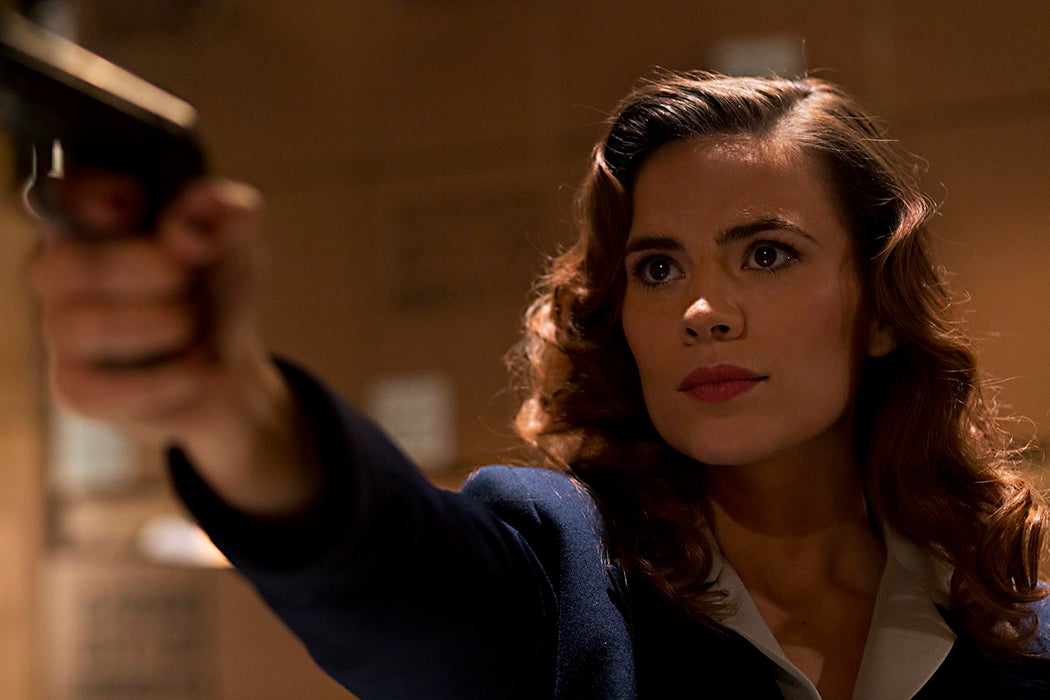We’re familiar with the image of Rosie the Riveter – the can-do girl who rolled up her sleeves and worked for the war effort at home while the boys were away – but Marvel has introduced another woman, Agent Peggy Carter, into the lexicon about women’s status in the military during and post-WWII.
But how did real women fit into the army and what was the impact of their service? The answer: pretty tremendous.
In the movie, Captain America: The First Avenger, Peggy Carter is a British Air force officer who joins the Strategic Scientific Reserve (SSR), a corps created to fight the Nazi super-weapons division, HYDRA. She successfully leads the rescue of Professor Abraham Erksine, allowing for the development of “Project Rebirth” and the creation of the Super Soldier Serum, which turns skinny Steve Rogers into Captain America. During the war she’s an autonomous leader with combat experience, and a confidant to Captain America.
Despite societal and cultural norms of the day, women proved to be necessary participants in the World War II efforts and served in armies throughout the world. Britain established the Auxiliary Territorial Service (ATS) in 1938 to allow women to volunteer for the army in non-combat roles. In 1941, however, the British began using the female ATS soldiers to man the antiaircraft units – giant guns designed to bring the German Luftwaffe planes down – in mixed gender units and specifically because female soldiers could not be captured.
In the U.S., Massachusetts Congresswoman Edith Nourse Rogers (no relation to Steve) introduced a bill in May of 1941 to create a Women’s Army Corps (WAC). Women immediately filled positions as drivers, mechanics, radio operators, weather observers, aircraft warning reporters, weapons repairers, and parachute riggers, and quickly came to be admired for their ability to perform jobs as well as (or better than) their male counterparts. When they went to Europe, they performed so impressively that they were nicknamed “Eisenhower’s secret weapon.”
Nazis insisted that the survival of the Aryan race relied on women in the labor room rather than the battlefield, and this belief didn’t allow for even a female auxiliary unit until 1943, when the Nazi effort began to fail. Even then, measures to draft women were met with resistance and never implemented efficiently. German women did eventually serve in auxiliary units as clerks, accountants, interpreters, and administrative positions, but were never afforded full military status and, in a 1944 order from Hitler, were forbidden from being trained in the use of weapons.
In contrast to the Germans, the Soviet army mobilized their women from the outset and, unlike the U.S. and Britain, bypassed the auxiliary stage completely – Russian women were immediately granted full military status. More than eight hundred thousand women served in the Soviet army and half of them served in front-line duty, many as snipers and pilots. The 588th Night Bombers, an all-female regiment, were so effective at hitting their targets that the Germans nicknamed them the “night witches.” According to sniper Lance Corporal Maria Ivanovna Morozova, women were some of the most effective and accurate shooters in the Red Army.
ABC’s new television miniseries, Marvel’s Agent Carter, picks up Peggy’s journey in 1946. The war is over and Captain America is lost and presumed dead. She still works at the SSR but the post-war professional climate has reverted and she’s treated like a secretary by the boy’s club. Still, Peggy is resourceful, cunning, and dreaming for more – which is where her work with Howard Stark, inventor, starts to get interesting. Her work during WWII allows Peggy to redefine her experience as a professional woman (and kick some ass), while serving as an entertaining heroine with roots in the early feminist movement.
The real women who served in the military during World War II may not have helped created a super soldier, but did prove – once necessity overcame the cultural norms of the time – that success in combat was a matter of skill, intelligence, coordination, training, morale, and teamwork, and that those attributes were not found only in men.







